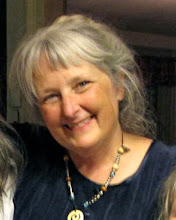Traffic
One of my first impressions of India, waiting in Newark for the flight to Delhi, forms the main metaphor through which I see road travel within India.
Bounded on two sides like the "line," traffic on the road moves forward steadily and organically at a level of organization much more complex than on western roads. For one thing, the modes of transport are incredibly diverse, a reflection of the intricacy of the culture. Then, each unit: car, truck, motorcycle, auto-rickshaw, bicycle-rickshaw, bicycle, ox- or buffalo-drawn cart, cow, elephant, pedestrian, dog, whatever, always fills the next empty space. There's an accepted hierarchy, a caste system, for who moves forward first. (Basically, more power wins, but power is a complicated concept.)

Except in big cities, you rarely see red lights, stop signs, or police, though more police than lights or stop signs. The traffic generally moves forward on the left, but an empty space is filled whether it's on the proper side of the road or not. Most vehicles don't have rear or side view mirrors, and what mirrors there are usually point at the back seat. Sounds pretty frightening, doesn't it? But it works. The trick is that each driver is only responsible for not hitting whatever is in front of him.

It is true that there are statisically more accidents in India than in many other countries, but not what you'd expect. Considering how crowded India is, the system works remarkably well. During my month-long stay, which involved quite a few extended road trips, I only saw an animal hit once— an aggressive lorry-driver cuffed the last cow in a herd crossing a country road — and we only had one taxi-driver whose style was truly terrifying. In general, I felt as safe as I do in the west, perhaps safer.
For me, the worst part of road travel is the pollution, both the noise and the air.
The noise is integral to the system. One is expected to honk the horn when passing or going around a corner or curve. It's considered polite and safe. So, day and night, horns are honking in India. Lots of them. Not very nice.
The air pollution is even worse. Except in big, sophisticated places like New Delhi, there are no rules about emissions. The smell of exhaust is awful. The yogic practice of khumbak, holding your breath, comes in very handy, as does the end of the dupatta (scarf) for covering your nose and mouth. And when you travel by rickshaw or auto, you're right out in the open, inhaling all that horrible stuff.
Still, it's easier and cheaper to get around Delhi without a car of your own than it is to maneuver the public transportation system in New York, and riding though the countryside in an auto or rickshaw is an absolute delight. As to the noise and crowds, as the Indians would say, what can you do? And, as to the air pollution, as an American I say, do something! Not soon, now!
Bounded on two sides like the "line," traffic on the road moves forward steadily and organically at a level of organization much more complex than on western roads. For one thing, the modes of transport are incredibly diverse, a reflection of the intricacy of the culture. Then, each unit: car, truck, motorcycle, auto-rickshaw, bicycle-rickshaw, bicycle, ox- or buffalo-drawn cart, cow, elephant, pedestrian, dog, whatever, always fills the next empty space. There's an accepted hierarchy, a caste system, for who moves forward first. (Basically, more power wins, but power is a complicated concept.)

Except in big cities, you rarely see red lights, stop signs, or police, though more police than lights or stop signs. The traffic generally moves forward on the left, but an empty space is filled whether it's on the proper side of the road or not. Most vehicles don't have rear or side view mirrors, and what mirrors there are usually point at the back seat. Sounds pretty frightening, doesn't it? But it works. The trick is that each driver is only responsible for not hitting whatever is in front of him.

It is true that there are statisically more accidents in India than in many other countries, but not what you'd expect. Considering how crowded India is, the system works remarkably well. During my month-long stay, which involved quite a few extended road trips, I only saw an animal hit once— an aggressive lorry-driver cuffed the last cow in a herd crossing a country road — and we only had one taxi-driver whose style was truly terrifying. In general, I felt as safe as I do in the west, perhaps safer.
For me, the worst part of road travel is the pollution, both the noise and the air.
The noise is integral to the system. One is expected to honk the horn when passing or going around a corner or curve. It's considered polite and safe. So, day and night, horns are honking in India. Lots of them. Not very nice.
The air pollution is even worse. Except in big, sophisticated places like New Delhi, there are no rules about emissions. The smell of exhaust is awful. The yogic practice of khumbak, holding your breath, comes in very handy, as does the end of the dupatta (scarf) for covering your nose and mouth. And when you travel by rickshaw or auto, you're right out in the open, inhaling all that horrible stuff.
Still, it's easier and cheaper to get around Delhi without a car of your own than it is to maneuver the public transportation system in New York, and riding though the countryside in an auto or rickshaw is an absolute delight. As to the noise and crowds, as the Indians would say, what can you do? And, as to the air pollution, as an American I say, do something! Not soon, now!


0 Comments:
Post a Comment
<< Home